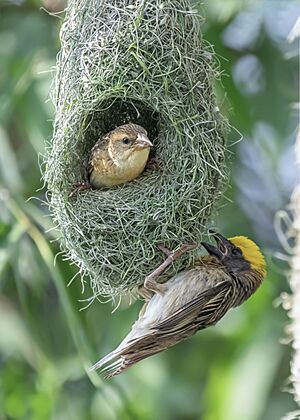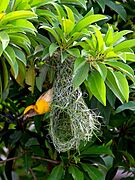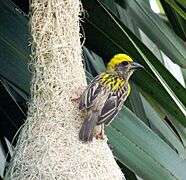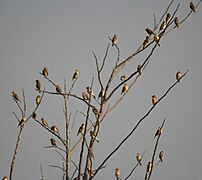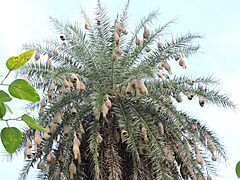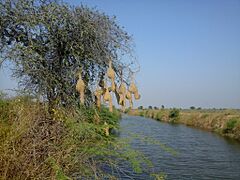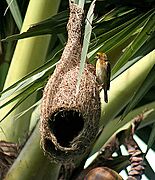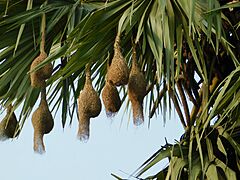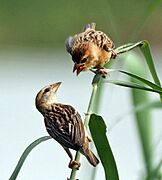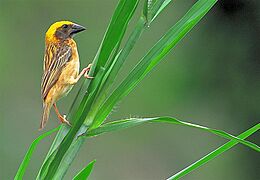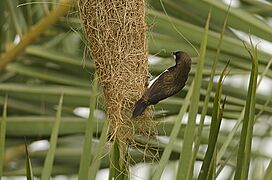Baya weaver facts for kids
Quick facts for kids Baya weaver |
|
|---|---|
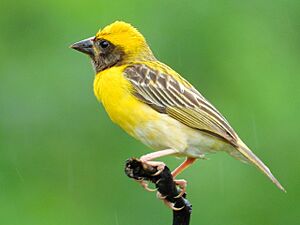 |
|
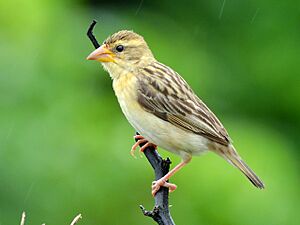 |
|
| Male and female P. p. philippinus (India) | |
| Conservation status | |
| Scientific classification | |
| Genus: |
Ploceus
|
| Species: |
philippinus
|
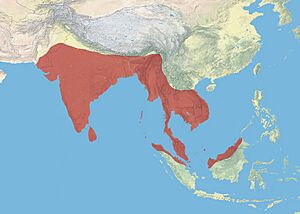 |
|
| approximate distribution | |
| Synonyms | |
|
Loxia philippina Linnaeus, 1766 |
|
The baya weaver (Ploceus philippinus) is a small weaverbird. You can find these birds across the Indian Subcontinent and Southeast Asia. They often live in grasslands, farms, and bushy areas. These birds are famous for their amazing hanging nests. The nests look like a long tube or bottle and are woven from leaves.
Baya weaver nests are usually built in groups on thorny trees or palm leaves. They are often near or over water. This helps protect the nests from animals that might try to eat the eggs or chicks. These birds are common in their home areas. However, they sometimes move around depending on the rain and where they can find food.
There are five main types, or subspecies, of the baya weaver. For example, the philippinus type lives in most of mainland India. The burmanicus type is found further east in Southeast Asia.
Contents
Meet the Baya Weaver
These birds are about the size of a house sparrow, around 15 centimeters (6 inches) long. They have a strong, cone-shaped beak and a short, square tail.
How to Spot Them
When they are not breeding, both male and female baya weavers look similar. They are streaky dark brown on top and plain whitish underneath. They have a long, buff-colored eyebrow. Their beak is horn-colored, and they don't have a dark mask.
During the breeding season, the male birds change. They get a bright yellow crown on their head. They also have a dark brown mask around their eyes and a blackish-brown beak. Their upper body becomes dark brown with yellow streaks. Their chest turns yellow, and their belly is creamy buff.
Life and Habits of the Baya Weaver
Baya weavers are very social birds. They like to live and find food in large groups. They eat seeds, which they find on plants and on the ground. When they fly, they often stay close together. They can perform amazing turns and dives in the air.
Sometimes, they eat rice and other grains from farms. Because of this, farmers sometimes see them as pests. Baya weavers often sleep in tall reeds near water. They rely on wild grasses and crops like rice for both food and nest building material. They also eat insects, and sometimes even small frogs or snails, especially to feed their young. Their movements depend on where they can find food.
Sounds They Make
Baya weavers make a continuous chit-chit- sound. Sometimes, it ends with a wheezy cheee-eee-ee. The males often sing this song together in a chorus. When it's not breeding season, their calls are quieter.
These birds also like to take dust baths on the ground.
Building Amazing Nests
Baya weavers breed during the monsoon season. They usually nest in groups of 20 to 30 birds. They choose spots close to food, nesting materials, and water.
Male baya weavers are famous for building their amazing nests. These nests hang down and are shaped like a bottle or retort. They have a main room for the eggs and chicks. A long, vertical tunnel leads to a side entrance into this room.
How Nests Are Built
The nests are woven from long strips of leaves from rice plants, grasses, or palm fronds. Each strip can be 20 to 60 centimeters (8 to 24 inches) long. A male bird might make up to 500 trips to finish one nest! They use their strong beaks to strip and collect the strands. Then, they weave and knot them together.
Nests often hang over water from palm trees. They can also be found on thorny Acacia trees or even telephone wires. While they prefer thorny trees, they sometimes build nests on street trees in cities. Nests are often on the east side of a tree. This might protect them from the strong Southwest Monsoon winds.
From Start to Finish
It takes about 18 days for a male to build a complete nest. The first part, called the "helmet stage," takes about eight days. At this stage, the nest looks like a helmet without the long entrance tunnel.
Once the helmet stage is done, the males start showing off to females. They flap their wings and call out while hanging from their nests. Females will inspect the nest. If a female likes it, she accepts the male. After they pair up, the male finishes the nest by adding the entrance tunnel. Males do most of the building. However, females might add some finishing touches inside, like blobs of mud.
Studies show that where a nest is built is more important to a female than how it looks. Females prefer nests high in trees, over dry land, and on thin branches.
Family Life
Both male and female baya weavers can have more than one mate. Males build several partial nests. They try to attract different females to each one. A male only finishes a nest after he finds a mate for it.
The female lays about two to four white eggs. She sits on them for about 14 to 17 days. Sometimes, the males help feed the chicks. The young birds leave the nest after about 17 days. After a male mates with one female, he often goes to court other females at his other partially built nests.
Sometimes, a female might lay her eggs in another female's nest. Young birds look different when they first leave the nest. They get their adult feathers after about four to six months. Young birds move to new places, usually not far from where they were born. Females can start breeding after one year, while males take about a year and a half.
Nest Protection
The nests hang from thorny trees and over water, which helps protect them. But some animals can still get to them. Crows sometimes eat the eggs or chicks. Lizards or rodents might also take over a nest. Sometimes, other birds like munias or Indian silverbills use abandoned baya weaver nests.
Baya Weavers in Culture
There's a common old story in India that baya weavers stick fireflies to their nest walls with mud to light up the inside at night. While they don't use fireflies, male baya weavers do add blobs of mud and animal dung to the nest chamber before they find a mate. Some people think the clay might help make the nest stronger in strong winds.
In the past, people in India trained baya weavers for entertainment. These birds were very clever and could pick up objects when their trainers told them to. They were trained to fire toy cannons, string beads, and pick up coins. People would travel around the country showing off their trained birds. One trick was for the bird to take a sweet and place it between a lady's lips. Another trick involved the bird spinning a thin stick with fire on the ends over its head. These amazing feats were noted as far back as the time of Emperor Akbar.
The baya is like a wild sparrow but yellow. It is extremely intelligent, obedient and docile. It will take small coins from the hand and bring them to its master, and will come to a call from a long distance. Its nests are so ingeniously constructed as to defy the rivalry of clever artificers.
Local Names for the Baya Weaver
- Túkúra Sorai (Assamese: টোকোৰা চৰাই)
- baya, son-chiri (Hindi)
- bayya chirya (Urdu: بیّا چڑیا )
- ବାୟା ଚଢ଼େଇ (Odia)
- sugaran (Marathi)
- tempua (Malay)
- sughari (Gujarati)
- বাবুই (babui) (Bengali)
- parsupu pita, gijigadu/gijjigadu గిజిగాడు (Telugu)
- gijuga ಗಿಜುಗ (Kannada)
- thukanam kuruvi, ആറ്റക്കുരുവി (Malayalam)
- thukanan-kuruvi, தூக்கணாங்குருவி (Tamil)
- wadu-kurulla, tatteh-kurulla, goiyan-kurulla (Sinhala)
- sa-gaung-gwet, sar-buu-daung စာဗူးတောင်း (Burmese)
- bijra (Punjabi: ਬਿਜੜਾ )
- suyam (Chota Nagpur)
- bagra(Maithili)
- संस्कृतम् (सुगृहः/चञ्चूसूचकः)
- Marathi (सुगरण पक्षी)
Gallery
-
Weaverbird at nest, West Bengal, India



